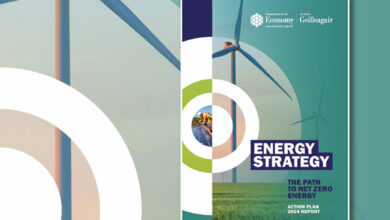Climate action: Guidance needed

agendaNi assesses the latest environmental figures in the absence of a new Programme for Government, expected to include key actions in tackling climate change and environmental improvements.
The New Decade, New Approach deal which brought about the resumption of devolved government in Northern Ireland included a number of significant pledges in relation to a strategic approach to the challenge of climate change. However, with many countries across Europe already well advanced in their environmental improvements and an ultimate goal of emitting zero carbon by 2050, the Northern Ireland Executive has yet to publish a fresh Programme for Government, giving clear direction to the region’s ambitions.
Currently, Northern Ireland’s environmental improvement measures are being largely guided by outcomes identified in the previous draft Programme for Government, devised prior to the collapse of the Executive and Assembly. In the Executive’s absence, these initial outcomes were transposed into an Outcomes Delivery Plan by the Northern Ireland Civil Service, first published in June 2018. However, such outcomes lacked hard, binding targets and instead sought to improve on a range of key indicators including greenhouse gas emissions, waste management and biodiversity.
Northern Ireland’s last functioning Programme for Government included a target to reduce greenhouse gas emissions by at least 35 per cent on 1990 levels by 2025. However, with significant advancements across Europe, including the Paris Climate Accord and the UK’s decision to declare a climate emergency in May 2019, it is likely that this target will be revised.
New Decade, New Approach set out plans for a long-awaited Climate Change Act, which would legally underpin environmental targets. Alongside those targets set to be included in a new Programme for Government will be a new Energy Strategy, which is currently being developed, led by the Department for the Economy, and will set out a roadmap for a zero carbon society transition.
Northern Ireland is currently the only region of the UK without an Environmental Protection Agency, which would serve as an independent oversight body in ensuring targets are met. New Decade, New Approach sets out an ambition to establish one, however, to date this has not happened. The predicted detrimental economic impact of Covid-19 has recently prompted a range of business, community and environmental groups to lobby Northern Ireland’s joint leaders to use the crisis to integrate a planned “Green New Deal”, also outlined in the New Decade, New Approach document, into any economic recovery strategy.
Released in May 2020, the Northern Ireland Environmental Statistics Report sets out progress against some of the key indicators included in the Programme for Government. While progress has been made in some areas, cause for concern exists around the extent of the achievements.
A prime example is in the area of greenhouse gas emissions. Figures for 2018 show that after a minimal rise between 2016-2017, Northern Ireland’s greenhouse gas emission dropped by 2 per cent. This represents a 20 per cent decrease from the baseline year of 1990. In comparison, The UK reduced emissions by 43 per cent in the same period. England and Scotland reduced emissions by 46 per cent and 45 per cent respectively, while Wales reduced emissions by 31 per cent. While the Programme for Government will record Northern Ireland’s 2 per cent decrease as a positive change, the overall 20 per cent decrease represents a significant gap from the 35 per cent by 2025 target, originally outlined in the Programme for Government 2011-2015.
“If policy-makers choose to set a similar target of zero carbon emissions in Northern Ireland by 2050, then it would need to eradicate 19.4 million tonnes of carbon dioxide equivalent (MtCO2e) in the next 30 years, a tall ask when considering that just 4.86 MtCO2e has been eradicated in the previous 30.”
The UK’s Climate Change Act, which without its own legislation, Northern Ireland has opted to be bound by and contribute towards wider UK targets, has committed the UK to reducing emissions by 100 per cent by 2050 from those 1990 baseline figures. Northern Ireland currently accounts for 4 per cent of the UK’s total greenhouse gas emissions, above its 3 per cent population share. If policy-makers choose to set a similar target of zero carbon emissions in Northern Ireland by 2050, then it would need to eradicate 19.4 million tonnes of carbon dioxide equivalent (MtCO2e) in the next 30 years, a tall ask when considering that just 4.86 MtCO2e has been eradicated in the previous 30.
Of course, greenhouse gas emissions is not the sole indicator of environmental improvements in Northern Ireland and will be just one element of a future Environment Strategy to be put to new Minister Edwin Poots, following the closing of a consultation by the Department of Agriculture, Environment and Rural Affairs in February this year.
Air quality
Air quality will also be a key focus. The Outcomes Delivery Plan sets out a key indicator to measure progress against the annual mean nitrogen dioxide concentration at monitored urban roadside locations. Nitrogen dioxide (NO2) is part of a group of gaseous air pollutants produced as a result of road traffic and other fossil fuel combustion processes and is monitored across 16 sites across Northern Ireland.
Air quality will also be a key focus. The Outcomes Delivery Plan sets out a key indicator to measure progress against the annual mean nitrogen dioxide concentration at monitored urban roadside locations. Nitrogen dioxide (NO2) is part of a group of gaseous air pollutants produced as a result of road traffic and other fossil fuel combustion processes and is monitored across 16 sites across Northern Ireland. average annual mean concentration of NO2 has fallen by over a quarter across Northern Ireland’s urban background sites in 2019 compared to 2011-2016 figures.
In relation to the Programme for Government indicator, the mean nitrogen dioxide level for the 10 sites used was 4.2μg/m3 less in 2019 than figures for 2014, meaning a positive change was recorded. While Northern Ireland’s nitrogen dioxide levels sit comfortably below those objectives set out for the UK and the EU, and are also decreasing, plans for greater electrification across transport modes and changes to heating systems, to eradicate fossil fuel combustion means that these objectives will likely be continuously revised downwards into the future.
A further challenge for Northern Ireland lies in the contribution of its agriculture sector to ammonia levels. Ammonia is recognised as an air pollutant and in Northern Ireland emissions have increased some 8.7 per cent in 2018 compared to 2001 levels. 90 per cent of all ammonia emissions in 2018 in Northern Ireland came from livestock. In total the emissions from livestock 10.6 per cent in Northern Ireland compared to 2001, compared to a 10.8 per cent decrease for the UK as a whole for the same period. Ambitions to reduce Northern Ireland’s levels of ammonia emissions, expected to be included in environmental improvement policy, will likely have to be balanced with the significance of Northern Ireland’s agricultural sector, most notably, its reliance on livestock and the subsequent economic contribution through exports.
In terms of water quality, the Outcome Delivery Plan looks at the indicators in relation to both Soluble Reactive Phosphorus (SRP) in rivers and Winter Dissolved Inorganic Nitrogen (DIN) in marine waters. When combined for the purpose of measurement, the indicator is reported as no change, however, a more detailed analysis highlights a need for actions in relation to these areas. Although minimal, Northern Ireland’s average concentration of SRP is above levels reported in 2015 and levels of DIN have increased significantly from 26.45 µM in 2015 to 35.71 µM in 2019, a negative change for Programme for Government Reporting.
An area where Northern Ireland’s future environmental targets will seek to build on previous successes is in relation to waste and specifically recycling. The EU’s Waste from Household target stated that by 2020 recycling of waste materials should be increased to 50 per cent. Northern Ireland reached the 50 per cent target in 2018/19, recognising significant annual increases and an 8 per cent rise from 2014/15 baseline year.
It is highly likely that any new environmental targets in regard to waste set out by the new Executive will attempt to align closely with revised legislative proposals on waste set out by the European Commission through its Circular Economy Package. Amidst its various ambitions, the EU aims to achieve a common EU target for recycling 65 per cent of municipal waste, 75 per cent of package waste and reduce landfill to a maximum of 10 per cent of municipal waste, by 2030.
These statistics serve as just some examples whereby Northern Ireland must seek environmental improvements and tackle climate change through new policy direction and initiatives. The absence of decision-making has meant that Northern Ireland has not been equipped to initiate the significant long-term plans already progressing in other parts of the UK, Ireland and Europe. With ministers now back around the Executive table, there is an expectation for the approval of a range of plans aimed at addressing the climate and environment challenges.







